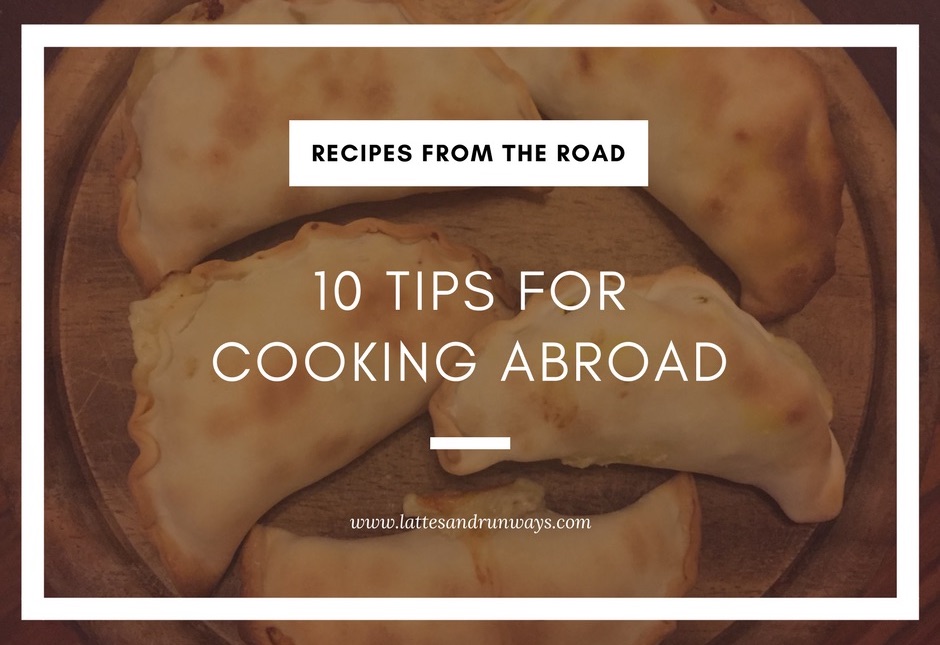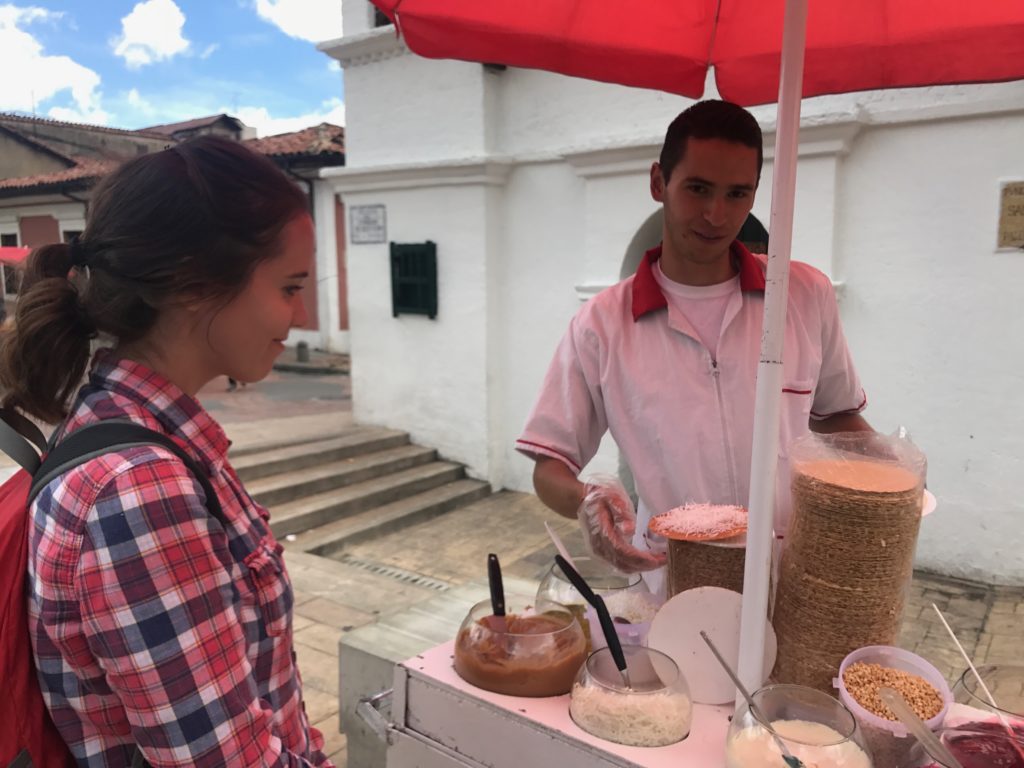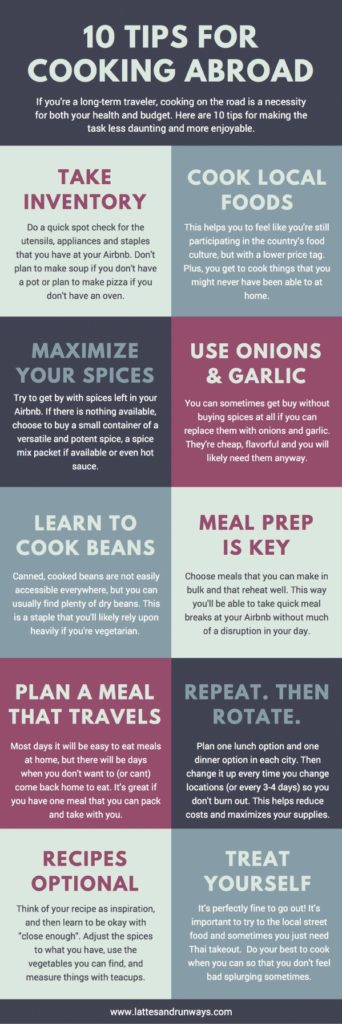
I’m excited to share my first post for a new series on Lattes & Runways: Recipes from the Road. In this series, I’ll take you into the Airbnb kitchens we find ourselves in and the meals we make in them. I’ve found fairly little information about this topic around the travel community, and I’m hoping to change that. I hope my fellow my travelers will find this useful and my non-traveling followers will at least enjoy the concept.
Cooking our own meals is just one of the many ways that long-term travel is different than vacation. We are living our lives very similarly to how we lived them back in the States, and that means we cook most of our meals at home. For a year of travel, cooking our own meals is absolutely essential from both a health and budgeting perspective.
We’re vegetarian, so often cooking our own food is easier than tracking down a vegetarian option (depending on the location). We’ve also found ourselves eating much healthier than we expected or planned. In the US, we relied heavily on fake meat products, like Beyond Meat crumbles (fake ground beef) and most of the Gardein lineup including (fake) pork bites, (fake) chicken strips and (fake) crab cakes. Since those items aren’t very prevalent in internationally, we’ve been forced to eat more natural meals with lots of fresh produce, beans and whole grains, which makes us feel a little better about the caramel waffles we snack on between meals.
 Let me tell you, cooking on the road is not the easiest thing. Every new city means grocery stores are stocked with different things, and the things they do have can have a huge swing in prices. You can get a craft beer at a bar for less than a pack of Spinach in Buenos Aires and a crappy frozen pizza will set you back almost $20 USD in Lima. Strangely enough, there are some grocery stores that we can’t even figure out how to shop at, like in Chile when we were told at the register twice that we couldn’t buy the onion, and we had no idea why (the other produce was fine, though!).
Let me tell you, cooking on the road is not the easiest thing. Every new city means grocery stores are stocked with different things, and the things they do have can have a huge swing in prices. You can get a craft beer at a bar for less than a pack of Spinach in Buenos Aires and a crappy frozen pizza will set you back almost $20 USD in Lima. Strangely enough, there are some grocery stores that we can’t even figure out how to shop at, like in Chile when we were told at the register twice that we couldn’t buy the onion, and we had no idea why (the other produce was fine, though!).
Not only do the availability and price of products vary, but each new city means a new Airbnb kitchen to adapt to with different cooking utensils and appliances. We didn’t have an oven in Cartagena, our Buenos Aires kitchen was basically an Easy-Bake Oven, and we had the worst knives ever in Santiago. Each Airbnb also is stocked with different basic cooking supplies. Sometimes we’ll be able to use staples in the kitchen like oil, hot sauce, or a handful of spices, which is insanely helpful (I’m not going to buy a whole bottle of oil just to fry potatoes three times).
Coming up with recipes that I can cook using the appliances I have, with groceries I can purchase, that don’t require a million ingredients is a constant balancing act. I wanted to share a few tips that have made this a little bit easier.
Let’s get started!
Tips for Cooking Abroad
- Take inventory. Do a quick spot check for the utensils, appliances and staples that you have at your Airbnb. Don’t plan to make soup if you don’t have a pot or plan to make pizza if you don’t have an oven.
- Cook Local Foods. This helps you to feel like you’re still participating in the country’s food culture, but with a lower price tag. Plus, you get to cook things that you might never have been able to at home.
- Maximize your spices. Try to get by with spices left in your Airbnb. If there is nothing available, choose to buy a small container of a versatile and potent spice, a spice mix packet if available or even hot sauce.
- Flavor with Onions and garlic. You can sometimes get buy without buying spices at all if you can replace them with onions and garlic. They’re cheap, flavorful and you will likely need them anyway.
- Learn to cook dry beans. Canned, cooked beans are not easily accessible everywhere, but you can usually find plenty of dry beans. This is a staple that you’ll likely rely upon heavily if you’re vegetarian. (Tip: Cook a big batch of black beans the first night and you can use them in a variety of recipes.)
- Meal Prep. Choose meals that you can make in bulk and that reheat well. This way you’ll be able to take quick meal breaks at your Airbnb without much of a disruption in your day.
- Plan a meal that travels. Most days it will be easy to eat meals at home, but there will be days when you don’t want to (or cant) come back home to eat. It’s great if you have one meal that you can pack and take with you.. We usually use sandwiches for our travel meal (super creative, right?).
- Repeat. Then rotate. Plan one lunch option and one dinner option in each city. Then change it up every time you change locations (or every 3-4 days) so you don’t burn out. This helps reduce costs and maximizes your supplies.
- Recipes optional. Think of your recipe as inspiration, and then learn to be okay with “close enough”. Adjust the spices to what you have, use the vegetables you can find, and measure things with teacups. It’s very rare that I have every single ingredient a recipe calls for (that’s if I have a recipe at all), and even less often do I have access to any measuring cups or spoons to get it right anyway. It’s all a guessing game and (usually) turns out fine.
- Treat yourself. It’s perfectly fine to go out! It’s important to try to the local street food and sometimes you just need Thai takeout. Do your best to cook when you can so that you don’t feel bad splurging sometimes.
I’d love to hear from other travelers and how they handle cooking on the road! Let me know if you have any tips you can share.

